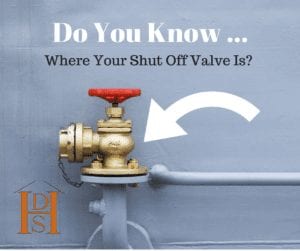Request Appointment
Contact Us

Questions & Answers & Tips
Plumbing Questions / Tips:
Have a question? Email us your questions
Do you know where your shut-off is located?
 Learning how to shut off your home’s water in an emergency can avoid costly water damage and save you money.
Learning how to shut off your home’s water in an emergency can avoid costly water damage and save you money.
Each plumbing fixture, such as dishwashers, faucets, water heaters and toilets, will often have its own dedicated shutoff valve. For freestanding fixtures, such as toilets or pedestal sinks, the shutoff valve can be easily located on the water supply line between the floor or wall and the fixture. Kitchen sinks, dishwashers and cabinet-mounted sinks would normally have their shutoff valves under the kitchen sink.
Shutting off water to fixtures mounted flush against the wall — bathtubs, showers, etc — may be harder to do locally because the valves (if they exist) may be hidden behind drywall.
Of course, finding the valve is one thing; whether you can turn it off with your bare hand is another. Because they are so rarely used, these valves may be hard to turn without a wrench. Try loosening each of these valves with some household spray oil so you’ll be able to shut them off quickly if you ever need to.
To prevent water damage be sure to follow these steps"
TO PREVENT WATER DAMAGE, BE SURE TO FOLLOW THE “3-STEP CHECK” OUTLINED HERE:
What to do when you discover a broken pipe
Whether your pipes are old, damaged or frozen, when they burst, you’ll need to stop the flooding. Don’t panic.
Here’s what to do.
Water valve
Whether your pipes are old, damaged or frozen, when they burst, you’ll need to stop the flooding. Don’t panic. Here’s what to do.
1. Find the water shut-off valve.
Knowing where your shut-off valve is crucial, especially in this situation. Finding it, however, is another story! Locations can vary depending on city water or private well and type of home and arrangement of your plumbing. Check these spots:
• the basement, near the front of the foundation wall within 3 to 5 feet of the main water entrance
• in a crawlspace
• in a mechanical room
• around the water heater or furnace
• under the kitchen sink
• in older homes, near the curb or sidewalk in a pit under a metal plate in your front yard
source: Angieslist.com
How much water does a leaking faucet waste?
Check your faucets at home — do any of them drip? Maybe it’s just a small drip — how much water can a little drip waste? A single drip won’t waste much water, but think about each faucet in your home dripping a little bit all day long. What if every faucet in every home on your block … in your town … in your state also dripped? The drips would add up to a flood of water wasted down the drain.
There is no scientific definition of the volume of a faucet drip, but after measuring a number of kitchen and bathroom sink faucets, for the calculations below (numbers are rounded), to use 1/4 milliliter (ml) as the volume of a faucet drip.
By these drip estimates: One (1) gallon = 15,140 drips. One (1) liter = 4,000 drips
Data herein is for informational purposes only – Click here for source
What is the typical water use at home?
Bath: A “full tub” varies, of course, but 36 gallons is good average amount. Tip: Taking a shower instead of a bath should save a good bit of water.
Shower: Old showers used to use up to 5 gallons of water per minute. Water-saving shower heads produce about 2 gallons per minute. Tip: Taking a shorter shower using a low-flow showerhead saves lots of water.
Teeth Brushing: <1 gallon. Newer bath faucets use about 1 gallon per minute, whereas older models use over 2 gallons. Tip: Simply turn the faucet off when brushing teeth.
Hands/face washing: 1 gallon Tip: Simply turn the faucet off before drying your hands and face. If you don’t mind a brisk wash, don’t run the faucet until it gets hot before using it. Installing a faucet-head aerator will also reduce the water flow rate.
Dishwasher: 6-16 gallons. Newer, EnergyStar models use 6 gallons or less per wash cycle, whereas older dishwashers might use up to 16 gallons per cycle. Tip: EnergyStar dishwashers not only save a lot of water but also save electricity.
Dish Washing by Hand: About 8-27 gallons. This all depends on how efficient you are at hand-washing dishes. Newer kitchen faucets use about 1.5-2 gallons per minutes, whereas older faucets use more. Tip: Efficient hand-washing techniques include installing an aerator in your faucet head and scraping food off, soaking dishes in a basin of soapy water before getting started, and not letting the water run while you wash every dish. And it’s best to have two basins to work in–one with hot, soapy water and the other with warm water for a rinse.
Clothes Washer: 25 gallons/load for newer washers. Older models might use about 40 gallons per load. Tip: EnergyStar clothes washers not only save a lot of water but also save electricity.
Toilet Flush: 3 gallons. Most all new toilets use 1.6 gallons per flush, but many older toilets used about 4 gallons. Tip: Check for toilet leaks! Adjust the water level in your tank. But, best to install a new low-flow toilet
Outdoor Watering: 2 gallons per minute, depending on the force of your outdoor faucet. This may not sound like too much but the large size of lawns and yards means outdoor water use can be a significant use of water.
Data herein is for informational purposes only – Click here for source
Should you upgrade your toilets?
Of course many times it’s a choice although not only will a toilet replacement make any bathroom remodel visually complete, it will save you money on utility bills if you use a municipal sewage company or reduce the amount of waste water that flows into your septic tank on a daily basis. The amount of water you’ll conserve by installing a replacement toilet may be significant, but if you are the adventurous type, there are a few other options to consider that are just beginning to catch on.
While toilet upgrades are far from the most glamorous home improvement projects on the planet, there are many benefits that toilet replacement is going to offer the average household for an inexpensive price.
A standard installation process will consist of:
-
-
-
-
-
-
-
-
-
-
-
- Turning off the water
- Draining, disconnecting and removing the old toilet
- Replacing the wax ring seal
- Inspecting the flange, which connects the toilet to the drainpipe, for damage or wear
- Setting and connecting the new toilet, as well as testing all newly installed parts
-
-
-
-
-
-
-
-
-
-
Financial / Business
Does Dupage Home Service offer Financing?
Yes and no … we don’t have in-house financing although we can direct you to our finance sources that will be able to accommodate your needs on a case-to-case basis. We work with individual clients to obtain the best financing instrument to suit their needs. Let us point you in the right direction!
Most jobs are on a cash basis and to be paid at time of service unless otherwise agreed.
We do however accept Visa, Mastercard & Discover. If you are not comfortable with using your credit card directly you can always utilize the services of Paypal.
